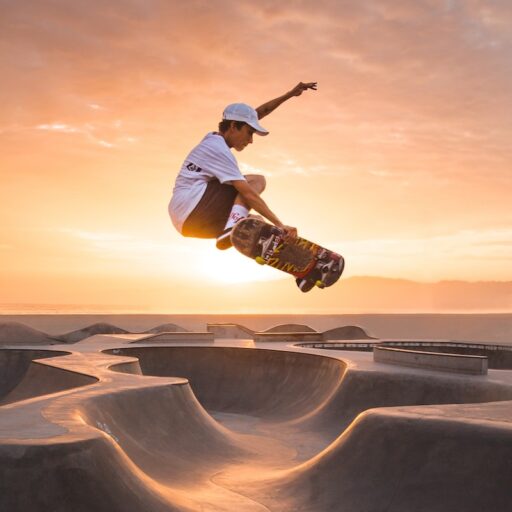Support our educational content for free when you purchase through links on our site. Learn more
“8 Essential Techniques to Halt Your Skateboard Like a Pro [2024] 🛹”
Ever found yourself hurtling towards an obstacle on your skateboard, heart racing, as you frantically search your brain for how to stop? You’re not alone. Stopping on a skateboard isn’t just about avoiding crashes; it’s an art form that, once mastered, can elevate your skating to new heights. But where do you start? With more methods than your average “Learn How to Stop on Your Skateboard” guide, we’re here to break down the ins and outs, ensuring you’ve got the know-how to halt with style and safety. Ready to dive in? Let’s roll!
Table of Contents
- Quick Answer
- Quick Tips and Facts
- The Evolution of Skateboard Braking
- Mastering the Basics: 4 Beginner Techniques
- Advanced Stopping Power: 4 Pro-Level Moves
- The Science of Skateboard Stopping
- FAQ
- Conclusion
- Recommended Links
- Reference Links
Quick Answer
Stopping on a skateboard involves a variety of techniques ranging from basic to advanced. Whether you’re cruising on flat ground or bombing down hills, knowing how to safely and effectively bring your board to a stop is crucial. We’ll cover everything from the simple foot drag to the exhilarating powerslide, ensuring you’re equipped for any situation. Ready to stop on a dime? Let’s get into it!
Quick Tips and Facts
- Foot braking is your go-to for most situations. ✅
- Powersliding isn’t just cool; it’s effective for high-speed halts. ❌ (Not for beginners!)
- Balance and body position are crucial across all stopping methods.
- Practice makes perfect. Don’t expect to nail these techniques on the first try.
The Evolution of Skateboard Braking
Skateboarding has come a long way since its inception in the 1950s. Initially, stopping was as rudimentary as jumping off the board. However, as skateboarding evolved, so did the techniques for halting. From the basic foot drag to the complex powerslide, each method has its roots in the rich history of skateboarding culture.
Mastering the Basics: 4 Beginner Techniques
1. Foot Braking
The most fundamental stopping technique. Simply place your back foot on the ground and apply pressure until you come to a stop. Remember, the key is gradual pressure to avoid losing balance.
2. Tail Scrub
Also known as the tail drag, this method involves shifting your weight to the back of the board, allowing the tail to scrape against the ground. It’s effective but can wear down your board over time.
3. Jump Off
Sometimes, the simplest solution is to bail safely. Knowing how to jump off your board in a controlled manner can prevent crashes.
4. Heel Drag
Similar to foot braking, but with an emphasis on dragging the heel of your back foot. This offers more control and is less tiring on long descents.
Advanced Stopping Power: 4 Pro-Level Moves
1. Powerslide
The powerslide is not only a showstopper but an effective way to halt at high speeds. It involves turning the board sideways and sliding on the wheels until you stop.
2. Revert
Combining a quick turn with a bit of slide, the revert can stop you in tight spaces. It requires good balance and timing.
3. Nose Pick
For those who like a challenge, the nose pick involves stopping the board with the front wheels lifted and the nose touching down. It’s tricky but rewarding.
4. Early Grab Air Brake
A technique borrowed from vert skating, the early grab air brake involves grabbing your board mid-air to slow down before landing. It’s advanced but effective in the right circumstances.
The Science of Skateboard Stopping
Understanding the physics behind each stopping method can greatly improve your technique. Factors like friction, momentum, and weight distribution play crucial roles in how effectively you can halt your skateboard. By mastering these concepts, you’ll not only stop more efficiently but also enhance your overall skating skills.
FAQ
What is the best way to stop on a skateboard?
The best method depends on your speed, the terrain, and your skill level. For beginners, foot braking is often the safest and most reliable method.
How do you brake or slow down on a skateboard?
Braking or slowing down can be achieved through methods like foot braking, tail scrub, or even a controlled powerslide for more experienced skaters.
How do I stop my skateboard from going down a hill?
Foot braking is effective for mild slopes, but for steeper hills, consider a combination of carving and powersliding to control your descent.
How do you not slip out on a skateboard?
Maintaining proper balance and gradually applying pressure during stopping techniques can prevent slipping. Also, ensure your shoes have good grip and your board’s grip tape is in good condition.
Conclusion
Mastering the art of stopping on a skateboard is essential for every skater, from the absolute beginner to the seasoned pro. By understanding and practicing these eight techniques, you’ll be well on your way to skating more confidently and safely. Remember, practice is key, and always wear protective gear while learning. Happy skating!
Recommended Links
- 👉 Shop Skateboard Gear on: Amazon | Walmart | eBay | Etsy
- Skateboard Brand Guides at Skateboard Brands™
- Skateboard Gear at Skateboard Brands™
- Skateboard Fashion at Skateboard Brands™
- Skateboard Culture at Skateboard Brands™
Reference Links
- Learn How to Stop on Your Skateboard at skateboardsafety.org
- How to Roller Skate for Beginners: 15 Steps to Mastering the Art 2024 🛼 at Skateboard Brands™
